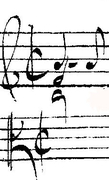The 2021 Annual Report
Balázs Mikusi
Thursday, April 21, 2022

The 2021 annual report for the RISM Editorial Center has now been published. You can read the report in its entirety on the RISM website. Here are some of the highlights:
The year 2021 was still overshadowed by the COVID pandemic and the diverse social restrictions inevitably also hindered RISM contributors from accessing source materials all around the world. Most working groups, nonetheless, found ways to keep adding new records, and the overall increase of source descriptions in the RISM database eventually surpassed our plans and amounted to over 112,000 new records.
Thanks to these additions, in October (the month that has long been considered as the end of the “RISM year”) the entire data pool in our catalog consisted of 1,555,811 records. This includes the authority files, which contain 142,142 authority records for personal names, as well as 31,938 for institutions (in the latter category, this year we managed to delete a significant number of entries stemming from import projects that were not relevant to the core RISM dataset). A total of 1,344,257 records remain for descriptions of musical sources, which can be further differentiated into 1,150,267 records for manuscripts and 192,564 for printed editions (the divergence from the previous year is due to a new counting method focusing exclusively on the basic source types). Meanwhile the number of links to digital objects has increased to over 85,920, once again a notable increase by almost 29,000.
Such significant enrichments to the dataset are essential so that RISM can remain an indispensable tool for both researchers and performing musicians, and strengthen its position as the “first stop” for scholars looking for historical music sources all over the world. Indeed, the unflagging interest is also reflected in the ever more intensive use of our catalog: on average, the RISM Catalog of Musical Sources was visited by about 10,500 people per month over 28,430 visits (annually: 126,000 people with 341,200 visits and 16.2 million page views).
Besides ongoing submissions from the international working groups (among which the ones in Germany and Poland were the most active in 2021 as well), the Editorial Center has for several years sought to expand RISM’s coverage by importing datasets from major national collections. As a crucial step in this process, 2021 saw the publication of over 60,000 records from the Istituto Centrale per il Catalogo unico delle Biblioteche Italiane (ICCU), which significantly improved the representation of Italian sources in the database. While further records from ICCU will also gradually be published in the coming years, the Editorial Center can now focus on its next major import project targeting the historical music manuscript collections of the Austrian National Library.
Such imports as a rule require considerable editorial work, but the Zentralredaktion views them as essential components of a strategy aimed at increasing not simply the size, but the overall research potential of the RISM database. Bringing together sources from different countries does not merely offer richer search possibilities for researchers and musicians alike, but can at the same time call attention to special relationships between different regions, thereby fostering the reconstruction of historical cultural networks. These in fact reach far beyond the borders of Europe: the records produced by the working group in South Korea, or the upcoming import of source descriptions from Mexico (also planned for 2022) effectively exemplify the enormous scholarly potential inherent in further expanding the international network.
While the worldwide pandemic presented the entire RISM community with diverse challenges, the increased interest in online communication channels also proved a source of inspiration. In an effort to ensure more direct interaction with RISM catalogers, we started to offer virtual “Muscat Coffee Hours” following important new releases of our cataloging software. The traditional “live” Muscat workshops that as a rule take place at major conferences also had to be “virtualized,” prompting an adaptation of the methodology and the teaching materials to the confines (as well as the new opportunities) of the different medium. Since the online workshops succeeded in reaching people who have had difficulties in taking advantage of traditional workshops (such as due to geographic distance or simply lack of travel funding), we plan to offer this alternative in the long run as well, even if international travel resumes its former dimensions.
Besides its active contributors, however, RISM also seeks to be in constant touch with its larger circle of users. The Editorial Center is active on Facebook and Twitter with more than 4,131 fans and over 2,768 followers, respectively. Since late 2020 a new website (designed in cooperation with the RISM Digital Center in Bern) also facilitates sharing information primarily about the activities of diverse RISM working groups, but also regarding musical source research in general.
Finally, a special group of scholars, librarians and music lovers has been targeted through a new initiative, a series of RISM Lectures. The virtual opening event took place on 28 January 2021 and presented to a more than 270-strong audience the new source descriptions of the Fondo Cappella Sistina with keynotes by Thomas Schmidt (University of Huddersfield) and Richard Sherr (Smith College). The second lecture featuring former RISM President Christoph Wolff (Harvard University) was offered on 26 May and focused on the Bach collection of the Berlin State Library. Recordings of both lectures, as well as the ensuing discussion, are also available on RISM’s YouTube channel.
Share Tweet EmailCatégorie: Nouveautés

